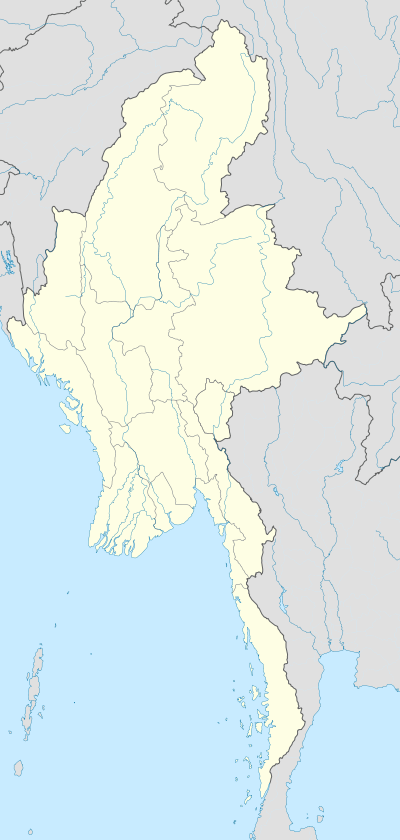Nat Ma Taung
| Nat Ma Taung | |
|---|---|
| Khaw-nu-soum / Mount Victoria | |
|
Nat Ma Taung/Mount Victoria | |
| Highest point | |
| Elevation | 3,070 m (10,070 ft) [1] |
| Prominence | 2,148 m (7,047 ft) [1] |
| Listing | List of Ultras of Southeast Asia |
| Coordinates | 21°14′00″N 93°54′00″E / 21.23333°N 93.90000°ECoordinates: 21°14′00″N 93°54′00″E / 21.23333°N 93.90000°E |
| Geography | |
 Nat Ma Taung Location in Burma | |
| Location | Chin State, Burma |
| Parent range | Chin Hills |
| Climbing | |
| First ascent | unknown |
| Easiest route | climb |
Nat Ma Taung (Burmese: နတ်မတောင်; also known as Mount Victoria and Khaw-nu-soum or Khonuamthung in Chin), is the highest mountain in the Chin State of western Burma.[2] Located in 3 Townships - Kanpatlet, Mindat and Matupi, Mount Victoria is part of the Chin Hills range. The park is administered by the Department of Forestry and Environment.
With a height of 3,053 metres (10,016 ft) above sea level and a prominence of 2,231 metres (7,320 ft), Nat Ma Taung is one of the ultra prominent peaks of Southeast Asia.[3]
Ecology
Nat Ma Taung lies in the Chin Hills-Arakan Yoma montane forests ecoregion. Surrounded at lower elevations by tropical and subtropical moist forests, Nat Ma Taung's higher elevations form a sky island, home to many temperate and alpine species typical of the Himalaya further north, as well as many endemic species.
The mountain is now protected within Nat Ma Taung National Park (နတ်မတောင်အမျိုးသားဥယျာဉ်), established in 1994.[4]
The base of this national park can be reached either via Kanpetlet Township (easy access) or via Mindat Township, the latter is not easy as the road is incomplete. The only public transport that reaches the base of the mountain is a four-WD jeep that plies between Soe and mountain base via kanpetlet in the dry season. The road up to the lodge after Kanpetlet town is sealed and beyond is an earthen tract. The tract is not navigable even by a 4-WD in the wet season due to severe damage by storm water. The tract is the main access to about 20 villages near the base of the mountain. At the base of the mountain, one tract leads to villages, the centre tract leads to the peak and the other one traverses to Mindat Township and them on to Soe Township. Due to tract damage, tourists, many national and few international, visit the mountain mainly in the dry season. The tract is navigable by a 4-WD car all the way to the peak.
It is said that the mountain is unique due to the presence of trees, bushes and grass even on its peak. Obviously, the trees and plants have developed own adaptations to the environmental factors in the park.
The mountain is "protected" by words only. Many activities that hinder the natural beauty and its bio-diversity are taking place unabated. The park is virtually not managed as there are no security personnel, park wardens and the like. One main threat that is affecting the bio-diversity of this national park is bush fire ignited by the action of local people. Trees were seen burning even on top of the mountain in 2014 May. The second issue tarnishing the beauty of the mountain is accumulation of litter, paper, cartons, cans, plastic, polythene and cans. The visitors are not provided with any instructions on what not to do within the park. There is no admission fee. The number of visitors to the peak is unknown. Foreign visitors during the year are about 100 whereas large number of local people visit the peak almost daily in the dry season.
The people living in all villages are poor. Basic services such as education, health and water supply are extremely poor. There are opportunities that could provide potential employment to local people especially the youth through promotion of eco-tourism. The engagement of youth as tourist guides will also help protect this beautiful mountain by educating the public as well as making them to be vigilant over destructive activities that are taking place at present. The development of eco-tourism is also seen as a potential vehicle to develop remote villages hugged within the park.
Gallery
- View from Nat Ma Taung's summit
- View from Nat Ma Taung's summit
- Morning view with travelers from Nat Ma Taung
See also
References
- 1 2 Peaklist - 19 Mountain Summits with Prominence of 1,500 meters or greater Retrieved 23 December 2013
- ↑ Kyaw Paing (2006) "22-Member Mountaineering Team Conquers Mt. Victoria in Chin State (1999)" Yangon University Hiking and Mountaineering Association, accessed 14 June 2009
- ↑ Peakbagger Mount Victoria, Myanmar
- ↑ Wikramanayake, Eric; Eric Dinerstein; Colby J. Loucks; et al. (2002). Terrestrial Ecoregions of the Indo-Pacific: a Conservation Assessment. Island Press; Washington, DC